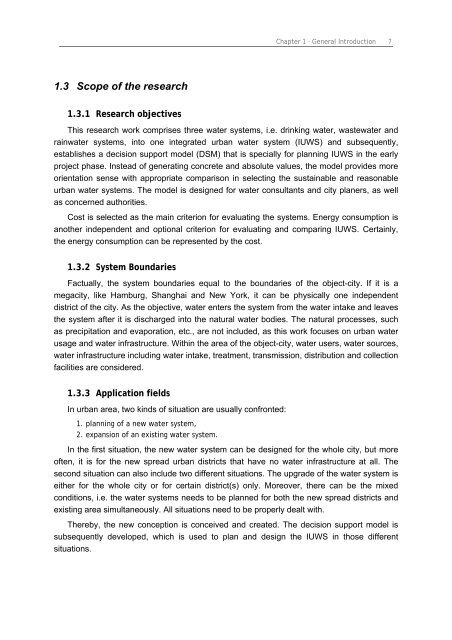Chapter 3 Decision Support Model (IUWS-DSM) - Tubdok
Chapter 3 Decision Support Model (IUWS-DSM) - Tubdok
Chapter 3 Decision Support Model (IUWS-DSM) - Tubdok
You also want an ePaper? Increase the reach of your titles
YUMPU automatically turns print PDFs into web optimized ePapers that Google loves.
1.3 Scope of the research<br />
1.3.1 Research objectives<br />
<strong>Chapter</strong> 1 · General Introduction 7<br />
This research work comprises three water systems, i.e. drinking water, wastewater and<br />
rainwater systems, into one integrated urban water system (<strong>IUWS</strong>) and subsequently,<br />
establishes a decision support model (<strong>DSM</strong>) that is specially for planning <strong>IUWS</strong> in the early<br />
project phase. Instead of generating concrete and absolute values, the model provides more<br />
orientation sense with appropriate comparison in selecting the sustainable and reasonable<br />
urban water systems. The model is designed for water consultants and city planers, as well<br />
as concerned authorities.<br />
Cost is selected as the main criterion for evaluating the systems. Energy consumption is<br />
another independent and optional criterion for evaluating and comparing <strong>IUWS</strong>. Certainly,<br />
the energy consumption can be represented by the cost.<br />
1.3.2 System Boundaries<br />
Factually, the system boundaries equal to the boundaries of the object-city. If it is a<br />
megacity, like Hamburg, Shanghai and New York, it can be physically one independent<br />
district of the city. As the objective, water enters the system from the water intake and leaves<br />
the system after it is discharged into the natural water bodies. The natural processes, such<br />
as precipitation and evaporation, etc., are not included, as this work focuses on urban water<br />
usage and water infrastructure. Within the area of the object-city, water users, water sources,<br />
water infrastructure including water intake, treatment, transmission, distribution and collection<br />
facilities are considered.<br />
1.3.3 Application fields<br />
In urban area, two kinds of situation are usually confronted:<br />
1. planning of a new water system,<br />
2. expansion of an existing water system.<br />
In the first situation, the new water system can be designed for the whole city, but more<br />
often, it is for the new spread urban districts that have no water infrastructure at all. The<br />
second situation can also include two different situations. The upgrade of the water system is<br />
either for the whole city or for certain district(s) only. Moreover, there can be the mixed<br />
conditions, i.e. the water systems needs to be planned for both the new spread districts and<br />
existing area simultaneously. All situations need to be properly dealt with.<br />
Thereby, the new conception is conceived and created. The decision support model is<br />
subsequently developed, which is used to plan and design the <strong>IUWS</strong> in those different<br />
situations.

















